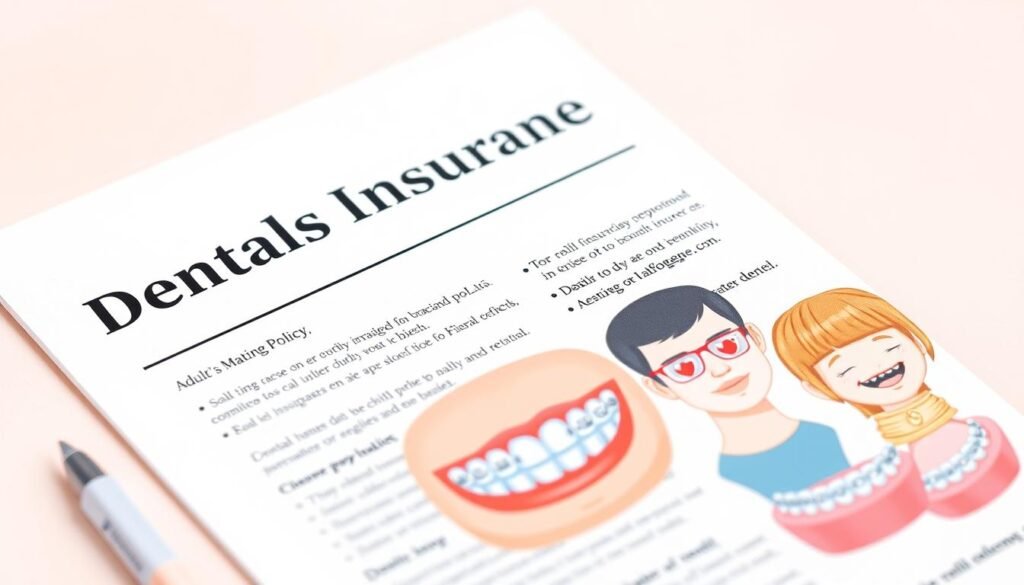Braces can transform your life for the better, giving you the smile you’ve always wanted. However, knowing how much do braces cost with insurance is a big worry for many people. Understanding the costs and what your insurance covers can make a significant difference.
This way, you can find a plan that works for both your budget and your smile goals, ensuring that achieving straight teeth is both affordable and achievable.
Table of Contents
ToggleKey Takeaways
- The average cost of comprehensive orthodontic treatment (including braces) ranges from $5,000 to $6,000, according to the American Dental Association.
- Dental insurance coverage for braces can vary widely, with many plans covering children but not adults.
- Factors like the type of braces, treatment duration, and your geographic location can impact the total cost.
- Strategies like researching multiple providers, exploring payment plans, and utilizing insurance or financial assistance programs can help make braces more affordable.
- Understanding the nuances of your insurance policy and the differences between in-network and out-of-network providers is crucial to maximizing your coverage and minimizing your out-of-pocket expenses.
Learn more about the factorsthat influence the cost of braces and strategies to make them more affordable
Understanding Braces Insurance Coverage
Getting braces can be expensive. But, dental insurance can help with the cost. The coverage varies by insurance plan. It’s important to know what your plan covers and to read your policy carefully.
Factors That Influence Coverage
Several things can affect how much braces cost with insurance. These include age limits, waiting periods, and if the treatment is needed or just for looks. Many plans only cover kids under 18. Some have waiting times before you can use the benefits.
If the braces are not medically necessary, you might pay more. This is because insurance might not cover the whole cost.
Importance of Reading Policy Details
It’s key to understand your insurance for braces. Look at your deductible, co-payments, and how much orthodontic care is covered. Talking to your insurance company can also clear up any confusion. This way, you know what you’ll pay and what’s covered.
Knowing how insurance works for braces can help you plan. It lets you make smart choices about your treatment. This way, you can get the braces you need without breaking the bank.
Types of Braces Covered by Dental Insurance
Dental insurance can help pay for different types of braces. This makes orthodontic treatment more affordable. The types of braces covered by dental insurance include metal, ceramic, and lingual braces.
Metal Braces
Metal braces are the most common and affordable choice. They are made of stainless steel and cost between $3,000 and $7,000. Insurance can cover a big part of this cost.
Ceramic Braces
Ceramic braces are a good choice for those who want to hide their braces. They are clear or tooth-colored and cost between $4,000 and $8,000. Many dental insurance plans cover this option.
Lingual Braces
Lingual braces are attached to the back of the teeth. They are less visible and cost between $8,000 and $10,000. Some insurance plans may help pay for this more advanced option.
The amount of coverage for these types of braces covered by dental insurance varies. It depends on your insurance plan. It’s key to check your policy and talk to your orthodontist and insurance provider. This way, you can understand what’s covered and save money.
How Much Do Braces Cost With and Without Insurance?
The cost of braces changes a lot. It depends on the type, where you live, and if you have insurance. Knowing the average costs helps you plan for your oral health.
Without insurance, braces can cost from $3,000 to $7,500 for metal ones. Ceramic braces cost $4,000 to $8,000. Lingual braces are $5,000 to $13,000. But, with 50% insurance, these costs drop to $1,500 to $3,750 for metal, $2,000 to $4,000 for ceramic, and $2,500 to $6,500 for lingual.
Remember, costs can change based on your dental plan, case complexity, and local orthodontist prices. Looking around and comparing can help you find the best deal.
| Braces Type | Cost Without Insurance | Cost With 50% Insurance Coverage |
|---|---|---|
| Metal Braces | $3,000 – $7,500 | $1,500 – $3,750 |
| Ceramic Braces | $4,000 – $8,000 | $2,000 – $4,000 |
| Lingual Braces | $5,000 – $13,000 | $2,500 – $6,500 |
Braces costs can really vary. It’s key to talk to your orthodontist and insurance about what you’ll pay. With the right info, you can choose the best braces for your budget and needs.
“Investing in braces can be a big financial step. But, the benefits for your teeth and smile are worth it.”
Does Dental Insurance Cover Braces for Adults and Children?
Dental insurance for braces varies a lot between adults and kids. Most plans cover braces for kids under 18 better than for adults. Adults might face more limits.
Age Restrictions and Limitations
About 25% of people with braces in the U.S. are adults. But, most dental insurance only covers kids under 19. This means adults might have yearly or lifetime limits on coverage.
Adults often have denser bones, leading to longer treatments and higher costs. Many dental insurance plans are made with this in mind, offering more for kids.
It’s key to check your dental insurance plan well. Know the age limits and restrictions for braces. This helps you decide how to pay for orthodontic treatment.
“Orthodontic treatments are considered essential benefits for children under the age of 18 under the Affordable Care Act (ACA).”
Even with limited adult braces coverage, there are ways to help pay. Look into Health Savings Accounts (HSAs), Flexible Spending Accounts (FSAs), or Medicaid. They can offer extra financial help.
Potential Benefits of Getting Braces
Getting braces might seem expensive, but they offer many benefits. They do more than just make your teeth look good. They can really improve your dental health and how you feel.
One big benefit of getting braces is fixing teeth that don’t line up right. This can stop tooth decay and gum disease. With straight teeth, it’s easier to clean them, which helps avoid oral health problems. Braces can also fix bites that are off, making it easier to chew and speak.
- Improved dental hygiene: Braces make it easier to brush and floss, reducing the risk of cavities and gum disease.
- Enhanced digestive health: Properly aligned teeth can contribute to better chewing and swallowing, which can have a positive impact on your overall digestive system.
- Boosted self-confidence: Achieving a straighter, more attractive smile can significantly improve your self-esteem and confidence, especially for younger patients.
The health benefits of braces are not just physical. They can also make you feel better emotionally. By fixing your teeth, braces can make you more comfortable and confident in public. This can lead to a better self-image and better relationships with others.
“Braces not only straighten your teeth but also boost your self-confidence and overall quality of life.”
In the end, the emotional benefits of braces are just as important as the physical ones. Whether you want to improve your dental health or look better, getting braces can change your life. It can positively affect many areas of your life.
Steps to Ensure Your Braces Are Covered by Insurance
Getting insurance to cover braces can be tough. But, knowing the right steps can help. It’s important to understand your insurance policy and what it covers.
Check Policy Details Thoroughly
Start by looking at your insurance policy carefully. Check for age limits, lifetime caps, and if you need to get approval for braces. This will tell you if your braces are covered and what to do next.
Confirm Medical Necessity
Insurance often asks for proof that you need braces. You might need to show that you have a big problem with your teeth. Work with your orthodontist to get the right papers and explain why you need braces.
Choose In-Network Providers
Picking an orthodontist in your insurance network can save you money. Network providers have deals with your insurance, which means you pay less. Make sure your orthodontist is in your network before you start treatment.
By following these steps, you can deal with insurance better. This way, you might get your braces covered, saving you money and making sure you get the care you need.
how much do braces cost with insurance
Figuring out the cost of braces can be tough. But knowing what your insurance covers can make it easier. The price of braces with insurance can change a lot. It depends on the type of braces, your insurance, and other things.
Industry data shows the typical costs for braces with 50% insurance coverage are:
- Metal Braces: $1,500 to $3,750
- Ceramic Braces: $2,000 to $4,000
- Lingual Braces: $2,500 to $6,500
But, the real cost can be more or less. It depends on your insurance, how complex your case is, and who you choose as your orthodontist. Check your dental insurance terms to know what’s covered and what’s not.
| Braces Type | Average Cost with 50% Insurance Coverage |
|---|---|
| Metal Braces | $1,500 to $3,750 |
| Ceramic Braces | $2,000 to $4,000 |
| Lingual Braces | $2,500 to $6,500 |
The cost of braces can change for many reasons. Like how complex your case is, the orthodontist’s experience, and where you live. Also, some insurance might cover part of the cost, while others might not cover it at all.
“Knowing the costs and what insurance covers is key for planning your budget for orthodontic treatment.”
Exploring Alternative Coverage Options
Looking into the cost of braces? Dental insurance isn’t the only choice. You can also use Health Savings Accounts (HSAs) or Flexible Spending Accounts (FSAs). Plus, Medicaid might cover it for some people.
Health Savings Accounts (HSAs) and Flexible Spending Accounts (FSAs)
HSAs and FSAs let you save money for medical costs before taxes. This includes orthodontic treatment. Using these accounts can lower your costs for braces. Just make sure you know the rules and limits to use them right.
Medicaid Coverage for Braces
Medicaid might help with braces, especially for kids. But for adults, it’s less common and varies by state. If you’re eligible, check Medicaid’s orthodontic benefits to see if they can help.
Looking into these options can make braces more affordable. Always check the details of each choice to find the best one for you.
In-Network vs. Out-of-Network Orthodontists
Choosing between in-network and out-of-network orthodontists affects cost and convenience. In-network providers offer care at agreed-upon rates, saving money. Out-of-network care costs more, with higher rates for procedures.
Understanding In-Network Benefits
In-network orthodontists make billing easier and handle insurance payments. This saves time and money. For example, Charleston Orthodontic Specialists works with all major insurance plans, making braces more affordable.
Out-of-Network Costs and Reimbursement
Out-of-network orthodontists cost more. Insurance may not cover as much, and providers can charge extra. It’s key to check coverage details to avoid unexpected costs.
FAQ
How much do braces cost with insurance?
FAQ
How much do braces cost with insurance?
The cost of braces with insurance can vary. Here are some examples:
– Metal braces: $1,500 to $3,750
– Ceramic braces: $2,000 to $4,000
– Lingual braces: $2,500 to $6,500
Your actual costs depend on your insurance, the type of braces, and other factors.
What factors influence the coverage of braces by dental insurance?
Several things affect braces coverage. These include age limits, waiting periods, and if braces are needed for health or looks. Always check your policy for details like deductibles and maximum benefits.
What types of braces are typically covered by dental insurance?
Insurance often covers metal, ceramic, and lingual braces. But, coverage varies by plan.
Is there a difference in insurance coverage for braces between adults and children?
Yes, kids under 18 get more coverage for braces. Adults face higher costs and longer treatment times due to denser bones.
What are the potential benefits of getting braces?
Braces offer many benefits. They prevent tooth decay and gum disease. They also fix bites and make cleaning teeth easier. Plus, they can improve digestion, speech, and self-confidence.
What steps can I take to ensure my braces are covered by insurance?
To get braces covered, follow these steps:
– Review your policy for coverage details and age limits.
– Show the need for braces with documentation.
– Choose an in-network orthodontist for lower costs.
– Get a pre-treatment estimate and pre-authorization if needed.
What are the differences between using in-network and out-of-network orthodontists for braces?
In-network orthodontists have deals with your insurance. This means lower costs for you. Out-of-network providers charge more, and you pay more upfront. You might also have to pay the difference not covered by insurance.
Are there any alternative coverage options for the cost of braces beyond dental insurance?
Yes, you can use Health Savings Accounts (HSAs) or Flexible Spending Accounts (FSAs) for braces. Medicaid might cover braces for kids in some cases. But, adult coverage is rare and varies by state.
,500 to ,750
– Ceramic braces: ,000 to ,000
– Lingual braces: ,500 to ,500
Your actual costs depend on your insurance, the type of braces, and other factors.
What factors influence the coverage of braces by dental insurance?
Several things affect braces coverage. These include age limits, waiting periods, and if braces are needed for health or looks. Always check your policy for details like deductibles and maximum benefits.
What types of braces are typically covered by dental insurance?
Insurance often covers metal, ceramic, and lingual braces. But, coverage varies by plan.
Is there a difference in insurance coverage for braces between adults and children?
Yes, kids under 18 get more coverage for braces. Adults face higher costs and longer treatment times due to denser bones.
What are the potential benefits of getting braces?
Braces offer many benefits. They prevent tooth decay and gum disease. They also fix bites and make cleaning teeth easier. Plus, they can improve digestion, speech, and self-confidence.
What steps can I take to ensure my braces are covered by insurance?
To get braces covered, follow these steps:
– Review your policy for coverage details and age limits.
– Show the need for braces with documentation.
– Choose an in-network orthodontist for lower costs.
– Get a pre-treatment estimate and pre-authorization if needed.
What are the differences between using in-network and out-of-network orthodontists for braces?
In-network orthodontists have deals with your insurance. This means lower costs for you. Out-of-network providers charge more, and you pay more upfront. You might also have to pay the difference not covered by insurance.
Are there any alternative coverage options for the cost of braces beyond dental insurance?
Yes, you can use Health Savings Accounts (HSAs) or Flexible Spending Accounts (FSAs) for braces. Medicaid might cover braces for kids in some cases. But, adult coverage is rare and varies by state.











